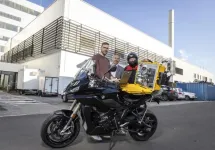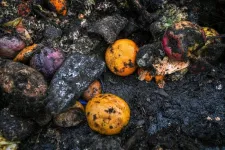(Press-News.org) COLUMBUS, Ohio – Tracking coyote movement in metropolitan areas shows the animals spend lots of time in natural settings, but a new study suggests the human element of city life has a bigger impact than the environment on urban coyote survival.
Researchers monitoring coyotes in Chicago found that habitat – areas with relatively high levels of vegetation cover and low levels of human infrastructure – did not influence coyote survival in positive or negative ways. Instead, areas densely populated with humans were associated with longer coyote lifespans.
“What we found was really interesting, in that the societal characteristics seem to play a much more important role in predicting coyote survival time than the environmental characteristics,” said Emily Zepeda, first author of the study and a postdoctoral scholar in the School of Environment and Natural Resources at The Ohio State University.
“And then we found this positive effect of human population density on survival time. Both of those things are unexpected because we usually associate human activity with detrimental effects on wildlife.”
The study was published recently in the journal Urban Ecosystems.
The data comes from the Urban Coyote Research Project, a long-term study of coyote ecology in the Chicago Metropolitan Area led by Stan Gehrt, a wildlife ecologist at Ohio State and senior author of the new paper.
Gehrt and colleagues estimate that 4,000 coyotes live in Chicago, one of the largest metropolitan areas in North America. Gehrt’s previous behavioral, genetics and biological studies offer hints at how coyotes have adjusted to life in the city. This new work sought to identify the diverse urban factors that help or hinder their ability to survive.
Tracking data on the movement of 214 coyotes living in the Chicago area between 2013 and 2021 was used for the study. The duration of each coyote’s tracking period served as a proxy of its survival time.
Potential factors the researchers predicted would affect urban coyote survival included a mix of societal and environmental characteristics: neighborhood median income, human density and demographics; and road density, parks and golf courses, and “disturbed” regions dominated by infrastructure and vacant land. These factors were analyzed alongside the coyote monitoring data in a statistical model to determine their relationships with survival time.
The results showed a positive relationship between survival rate and human population density – at low human densities, coyote survival was generally low. The data also revealed an interaction between neighborhood income and density: In areas with low human density, median income was not significantly associated with survival, likely due to the absence of humans. However, at moderate and high levels of human density, coyotes in lower-income areas were 1 1/2 times more likely to survive to age 2 than coyotes in high-income areas.
“We’ve hypothesized that population density may have a positive effect because it’s actually providing resources like human-related structures or food that allow coyotes to weather the harsh conditions of the winter, which is a major mortality factor for Chicago coyotes,” Zepeda said.
Plentiful resources might become problematic, she said, when the food and shelter, combined with more vegetation and less pollution in high-income areas, draws a crowd of coyotes – which leads to higher disease transmission and fighting over territory.
“There might be more individuals in those areas, but survival time may be shorter there,” she said. “You might die younger in an area where there are a lot of competitors.”
The findings build on growing evidence that societal processes that benefit and marginalize human populations trickle down to urban ecosystems – suggesting that the presence, or lack, of humans, and the conditions in which they live, has potential to override natural influences on urban wildlife.
And yet, it was surprising not to find a connection between natural habitats and longer survival, Zepeda said, because “anecdotally, we see really high densities of coyotes in nature preserves and urban parks. That’s often where you see coyotes in the city if you see them at all.”
Researchers can only speculate, but Zepeda said it could mean the habitat categories on city maps aren’t specific enough or that hunting and trapping is more common in natural settings. Or it could simply be a sign of how crafty coyotes are.
“It could speak to how adaptable they are that they might prefer natural habitat, but at least in terms of survival, they can do just as well in more urbanized areas,” she said.
This work was supported by Cook County Animal and Rabies Control, the Max McGraw Wildlife Foundation, the Forest Preserve District of Cook County, and a National Science Foundation Graduate Research Fellowship.
Andrew Sih of the University of California, Davis and Christopher Schell of the University of California, Berkeley were also co-authors.
#
Contact: Emily Zepeda, Zepeda.31@osu.edu
Written by Emily Caldwell, Caldwell.151@osu.edu; 614-292-8152
END
Given that today’s children will inherit the consequences of climate change, schools are instrumental in mobilizing a global response to the climate crisis, a science educator argues.
Climate literacy advocate Kelley T. Lê argues that climate change is the defining issue of our time, and in her new book, Teaching Climate Change for Grades 6–12: Activating Science Teachers to Take on the Climate Crisis Through NGSS, Lê provides teachers, administrators, and global leaders with practical tools to empower ...
The emissions scandal in the automotive industry that came to light in 2015 has set many things in motion. Last but not least, the discussion about the need for realistic tests for vehicles in order to correctly determine their pollutant emissions instead of just testing on test rigs. Such tests and the applicable emission limits are now required by law for cars, but not for so-called category-L vehicles (mopeds, motorbikes, tricycles and quads). As part of the “LENS” project (L-vehicles Emissions and Noise mitigation Solutions) funded by the European ...
Research Highlights:
More than one-third of Asian, Black and Hispanic women in the study group reported experiencing at least one microaggression related to race and gender during or after their pregnancy.
The link between racial microaggressions and postpartum blood pressure was strongest 10 or more days after delivery, when the blood pressure may be monitored less often, the researchers noted.
The researchers also noted that these types of gendered racial microaggressions can raise blood pressure postpartum and suggest blood pressure monitoring and/or treatment for high blood pressure may need to ...
If you’d like to solve a math problem on a good old-fashioned chalkboard, you want the board clean and free of any previous markings so that you have space to work. Quantum computers have a similar need for a clean workspace, and a team including scientists at the National Institute of Standards and Technology (NIST) has found an innovative and effective way to create and maintain it.
The research effort, a collaboration with physicists at Sweden’s Chalmers University of Technology, could address one of the main issues confronting quantum computer designers: ...
The United States generates more food waste than all but two countries. To address this, the federal government set a goal to cut food waste in half by 2030 compared to 2016 levels, to about 164 pounds per person annually. But a new study published in Nature Food and led by University of California, Davis, reveals that current state policies are falling short. Since 2016, per capita food waste has increased instead of decreasing.
“We’re just five years away from 2030 so it’s quite alarming how ...
Quantum computers require extreme cooling to perform reliable calculations. One of the challenges preventing quantum computers from entering society is the difficulty of freezing the qubits to temperatures close to absolute zero. Now, researchers at Chalmers University of Technology, Sweden, and the University of Maryland, USA, have engineered a new type of refrigerator that can autonomously cool superconducting qubits to record low temperatures, paving the way for more reliable quantum computation.
Quantum computers have the potential to revolutionise fundamental technologies in various sectors of society, with applications in medicine, energy, encryption, AI, and logistics. While the building ...
EMBARGO 9.1.2025
New discovery makes organic solar cells more efficient and stable
Researchers at Åbo Akademi University in Finland have identified and eliminated a previously unknown loss mechanism in organic solar cells that makes them more efficient and gives them a longer lifetime. The results provide new insight into how efficiency and stability can be increased in the future.
The work of the Organic Electronics Research Group at Åbo Akademi University was carried out in cooperation with Professor Chang-Qi Ma's group at Suzhou Institute ...
Fiber is well known to be an important part of a healthy diet, yet less than 10% of Americans eat the minimum recommended amount. A new study from Stanford Medicine might finally convince us to fill our plates with beans, nuts, cruciferous veggies, avocados and other fiber-rich foods. The research, which will be published in Nature Metabolism on Jan. 9 identified the direct epigenetic effects of two common byproducts of fiber digestion and found that some of the alterations in gene expression had anti-cancer actions.
When we eat fiber, the gut microbiome produces short-chain fatty ...
ORACLE test predicts overall cancer survival independent of currently used clinical risk factors, and it has the best predictive power in stage 1 lung cancer.
A high ORACLE score is associated with a higher risk of cancer spread.
ORACLE could potentially be used to pick out patients who would benefit most from chemotherapy.
Researchers at the Francis Crick Institute, the UCL Cancer Institute and UCLH have shown that a test called ORACLE can predict lung cancer survival at the point of diagnosis better than currently used clinical risk factors. This could help doctors make more informed treatment decisions for people with stage ...
UNDER EMBARGO UNTIL 10 AM GMT / 5 AM ET THURSDAY 9 JANUARY 2025
Pioneering new mathematical model could help protect privacy and ensure safer use of AI
AI tools are increasingly being used to track and monitor us both online and in-person, yet their effectiveness comes with big risks. Computer scientists at the Oxford Internet Institute, Imperial College London, and UCLouvain have developed a new mathematical model which could help people better understand the risks posed by AI and assist regulators in protecting peoples’ privacy. The findings have been published today (9 January) in Nature Communications.
For ...



